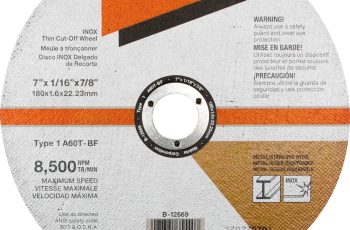When using variable speed die grinders, safety should be your top priority. Start by inspecting the tool for any damage and guarantee the accessories are compatible. Don’t forget your safety gear—glasses and gloves are essential to protect against flying debris. A firm grip with the tool directed away from the body is vital. But what about those vibrations and unusual noises? They’re more telling than you might think.
Key Takeaways
- Perform pre-use inspection for damage and verify RPM alignments to ensure safety.
- Always wear appropriate PPE, including eyewear and ear protection, to reduce injury risks.
- Secure workpieces firmly and maintain stable footing to prevent accidents.
- Use manufacturer-recommended accessories and confirm compatibility with grinder’s spindle.
- Adjust speed settings according to task requirements to minimize vibrations and enhance control.
Pre-Use Tool Inspection
Before using a variable speed die grinder, conducting a thorough pre-use tool inspection is essential to confirm safety and functionality. Start by examining the tool’s physical condition—look for cracks or visible damage. Verify the grinding wheel is defect-free and securely mounted with protective guards in place. Check the handles for secure attachment to maintain adequate control.
Next, inspect the electrical components. Confirm power cables are intact and connectors are industrial-grade. Verify the tool’s compatibility with the task at hand, confirming RPM ratings align with the wheel’s specifications. All safety devices, including guards and dead man switches, should function properly. Since variable speed die grinders can be either corded or battery-operated, ensure the power source is suitable and fully charged if applicable.
Document these checks on an inspection checklist, noting the inspector’s name and date for accountability.
Personal Protective Equipment
When using a variable speed die grinder, donning the right personal protective equipment (PPE) is essential for your safety. First and foremost, protective eyewear like safety glasses or goggles with side shields is critical to shield your eyes from flying debris and sparks. Don’t forget a full face shield for thorough protection, especially when debris levels are high. For hearing conservation, earplugs or earmuffs are important if noise levels exceed 85 decibels, which is common with die grinders. Regularly inspect these items for damage and verify they’re clean and well-maintained. Also, anti-vibration gloves, flame-resistant clothing, and proper footwear further protect you from the hazards of grinding, enhancing both safety and comfort during your work. Moreover, ensuring tools and attachments match is crucial to avoid risks such as abrasive disc shattering and flying debris, which underscores the importance of safety equipment.
Safe Operating Practices
Although operating a variable speed die grinder offers great flexibility and precision, adhering to safe operating practices is vital to minimize risks. Start by performing a pre-use inspection. Confirm all grinding bits are undamaged and securely fastened, and verify that accessory ratings meet or exceed the grinder’s maximum RPM. Proper grip is essential; hold the die grinder firmly with both hands for control and stability. Always point the tool away from your body. Tool positioning matters—maintain a stable stance to prevent losing control. Allow the grinder to reach full speed before contacting the workpiece, applying steady, moderate pressure. Remember to power down and disconnect the air supply before making adjustments, guaranteeing safety throughout your task. Proper stance is crucial for maintaining control during operation; thus, maintaining a stable stance is key to preventing accidents.
Work Environment and Setup
When working with a variable speed die grinder, it is vital to secure your workpiece firmly to avoid any movement that could lead to accidents. Consistently maintaining your balance is important—ensure your footing is stable to handle the tool effectively. Before starting, thoroughly inspect the area for any potential hazards to create a safer working environment. It’s important to note that router speed controls are designed primarily for brushed motors, which may influence your choice of tools and setup.
Secure Workpiece Firmly
Securing your workpiece firmly is one of the most critical steps in guaranteeing safety when using a variable speed die grinder. Achieving workpiece stability is essential; use proper clamping techniques to prevent movement during grinding. A sturdy clamp or vise is your best ally, keeping the workpiece steady and reducing the risk of accidents. Never hold the workpiece by hand—vibrations and the grinder’s speed can lead to loss of control.
Regularly inspect your clamping mechanism for wear or looseness. Confirm it’s on a stable surface, free of debris, and position the workpiece so grinding is directed safely away from you and others. Remember, proper lighting and clear, accessible workspace arrangements enhance safety and efficiency during your grinding tasks.
Maintain Balance Consistently
Guaranteeing consistent balance in your work environment and setup is vital for safe and effective use of a variable speed die grinder. Tool stability begins with a level workbench equipped with rubber feet or anti-slip mats to curb vibrations. Proper operator positioning is essential; maintain a balanced stance with feet shoulder-width apart, avoiding overreach by keeping close to your workpiece. Use both hands on the die grinder to enhance control. Check the tool’s weight distribution to minimize fatigue. Adjust the workbench height for ergonomic comfort, and wear non-slip footwear to secure your footing. Regularly monitor for vibrations, stopping immediately if detected, and verify accessories are properly balanced. A well-prepared environment greatly enhances safety and precision in your grinding tasks.
Inspect Area Thoroughly
A well-organized workspace is essential for safe and efficient use of a variable speed die grinder. Start with hazard identification by thoroughly inspecting the area for clutter and potential hazards. Remove unnecessary objects and debris to eliminate tripping risks. Verify the floor is dry and clean to prevent slips and falls. Arrange tools and materials for easy access, avoiding congested spaces that hinder movement. Secure cables and hoses away from walkways. Confirm adequate ventilation and dust control to reduce inhalation risks. Clear flammable materials to prevent fires from sparks. Also, inspect and secure your workpiece to avoid unexpected shifts. By focusing on clutter reduction and safety setup, you’ll create a safer, more productive work environment.
Accessory Use and Handling
When handling accessories for a variable speed die grinder, it’s vital to prioritize compatibility and secure attachment to guarantee safe operation. Always confirm accessory compatibility by matching the accessory to your grinder’s spindle size and type. Proper accessory selection is imperative; only use manufacturer-recommended items designed for your specific applications to avoid failures, such as shattering cut-off wheels. Verify that accessories meet safety standards, like ANSI or EN, for reliable performance.
Before installation, disconnect the power supply to prevent accidental startups. Ascertain accessories are securely fastened—especially with collets—without over-tightening, which might damage the accessory or tool. Inspect accessories visually for any damage like cracks or chips. Proper handling maintains safety, minimizes vibration, and prevents potential injuries during use.
Electrical and Mechanical Safety
Proper electrical and mechanical safety measures are critical when operating variable speed die grinders. To mitigate electrical hazards, always use grounded outlets and inspect power cords for any damage. Replace any frayed cords immediately to prevent shocks or power loss. Keep cords away from cutting surfaces to avoid accidental damage. Avoid using the grinder in damp environments to reduce shock risks.
Address mechanical risks by selecting the appropriate speed for your task to maintain control and prevent kickback. Engage safety features like paddle switches to stop the tool instantly when released. Always maintain a firm grip and control pressure; excessive force can lead to damage or injury. Ascertain the grinder is directed away from your body to avoid injury from debris.
Understanding RPM Compatibility
Understanding RPM compatibility is vital for maximizing the efficiency and safety of variable speed die grinders. Knowing the RPM standards and matching them with accessory ratings is important. Tools like the Milwaukee M18 FUEL offer precise RPM control, which helps in task optimization. You need to verify that the accessories you use, like grinding wheels or cutting discs, are rated appropriately to avoid safety hazards. Exceeding these ratings can lead to catastrophic failures, posing significant risks. By adhering to RPM compatibility, you not only enhance tool performance but also extend the lifespan of both the tool and its accessories. Always check that your tool’s RPM settings align with the task and accessory demands for safe and efficient operation.
The Importance of Secure Attachments
While using a variable speed die grinder, guaranteeing secure attachments is essential for both safety and performance. Attachment stability is vital—inspect each accessory for damage and verify it’s properly secured. The fit matters; confirm your accessory compatibility by matching the shank size exactly with the collet. Secure the attachment by inserting the bit at least 3/4 of the shank length, and tighten the collet nut without overdoing it to avoid damage. Using incompatible accessories can cause dangerous vibrations and breakage. Disconnect the power before changing attachments to prevent accidental start-up. Regular checks and following manufacturer instructions keep both you and your tools safe, minimizing risks of flying debris and assuring efficient, quality work.
Recognizing and Managing Tool Vibrations
Vibrations in variable speed die grinders can severely impact both safety and performance, so recognizing and managing them is essential. Start by using vibration detection methods like digital meters or smartphone apps to measure vibrations accurately. Listen for unusual noises or excessive shaking during startup, as these signal imbalances or wear. For effective vibration mitigation, regularly inspect and replace worn bits and collets, and adjust speed settings to the task. Anti-vibration gloves can help reduce the impact on your hands. Pay attention to signs like hand numbness, indicating harmful vibrations. Opt for grinders with features like brushless motors and electronic feedback systems to help maintain balance and reduce vibration. These steps will enhance safety and improve tool longevity.
Conclusion
To sum up, when you’re using variable speed die grinders, always prioritize safety. Start with a thorough pre-use inspection and guarantee you’re wearing the right protective gear. Operate the grinder with a steady grip, keeping it away from your body, and let it reach full speed before engaging the workpiece. Be mindful of your surroundings and tool vibrations, and ensure RPM compatibility for secure attachments. By following these guidelines, you’ll enhance both safety and performance.

